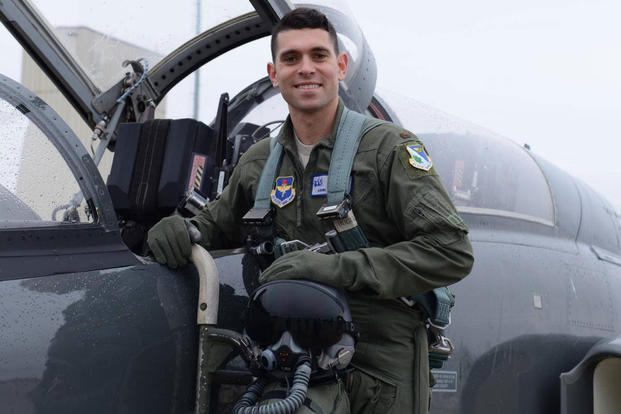An engine compressor stall during a routine touch-and-go flight certification led to a fatal T-38 Talon trainer crash at Laughlin Air Force Base, Texas, in November, according to a recent Accident Investigation Board report.
The stall resulted in a loss of majority thrust from the right engine, causing the aircraft to roll to the right. It could not restabilize, and as a result the aircraft drifted downward and ultimately crashed, the report said.
Capt. John F. Graziano, 28, an instructor pilot with the 87th Flying Training Squadron, was killed in the crash. He had been flying with Capt. Mark Palyok, also an instructor pilot with the 87th, to keep Palyok's certification up-to-date in rear-cockpit night landing training.
Graziano was from Elkridge, Maryland. At the time, the crash was the 5th involving a T-38 in just 12 months.
Related: Air Force Identifies Pilots Killed, Injured in Latest T-38 Trainer Crash
According to the report, the pilots were on their fifth touch-and-go nearly 45 minutes into the training flight. As the engines advanced into "MIL power" -- a power setting typically used for touch-and-go landings that corresponds with "100% rotational speed of the engine" -- the pilots heard a loud noise.
"What's that?" One of the pilots, unidentified in the report, asked.
The loud buzz lasted about one second.
The plane then began gaining altitude after its touchdown. But as this was happening, the right engine's "rotational speed decreased from 97% to 66% and the Exhaust Gas Temperature (EGT) began to increase, indicative of a compressor stall and resulting in a loss of most of the thrust being provided by that engine," the report said.
Palyok momentarily reduced the power before attempting to bring it back to the MIL setting. Then, Graziano took over, attempting to do the same. The T-38 continued to drift downward, prompting the stall warning. But the trainer never regained speed, and failed to get more than 10 feet off the ground, the report said.
The T-38 soon skidded along the grass, 55 feet from the runway surface. Graziano raised the nose and hit MAX power on the engines, which would kick on the afterburner for additional thrust; it would only work in the left engine, but enough to get them slightly airborne again.
The pilots initiated their ejection. But as they readied to bail out, the aircraft reached full aerodynamic stall and rolled to the right, dropping the nose. Palyok bailed out; Less than a second later, Graziano would have done the same. But the aircraft crashed before he could.
The "impact interrupted [mishap pilot 1's] ejection sequence after the canopy departed, but before the forward seat ejected," the report said.
Brigadier General James R. Sears Jr., the investigation board's president, found that, in addition to the compressor stall, Graziano failed "to apply necessary throttle and flight control inputs following a loss of engine thrust on takeoff."
While both pilots were experienced, they had never experienced a real-life stall before, Sears said.
"There was a loud and unfamiliar sound, unexpected change in aircraft control, engine indications that did not clearly indicate a compressor stall or significant engine anomaly, and an engine malfunction neither [mishap pilot] had experienced in an actual T-38C," he said in his concluding remarks.
"These combined to create the effect that [Graziano] did not perceive that the [mishap aircraft] was drifting right of the runway surface at a very low altitude, nor did he react appropriately to the aural, [heads-up display, and multi-function display] stall indications."
When the nose pitched downward, it was too late for a successful ejection, Sears said.
What exactly caused the compressor stall was not determined The report noted various factors which could lead to a stall, such as engine structural failure; foreign object damage; incorrect fuel flow trim; high aircraft angles of attack at low airspeeds; low compressor inlet temperatures; unusual flight attitudes; among others.
"Compressor stalls are more common in high performance aircraft like the T-38C," the report said.
Service officials held a memorial shortly after the accident.
Graziano "showed up to work every day with a smile on his face, and--no matter what--he always gave his 100 percent," Col. Lee Gentile, 47th Flying Training Wing commander, said during a ceremony at the base. "For all the things John was, he would want to be remembered as an aviator."
The 87th is responsible for training student pilots, including specialized undergraduate pilot training for active-duty, Air Force Reserve, Air National Guard troops as well as foreign allied air forces.
The Air Force is on track to acquire new trainer jets to replace its current Northrop Grumman-made T-38s.
-- Oriana Pawlyk can be reached at oriana.pawlyk@military.com. Follow her on Twitter at @oriana0214.












